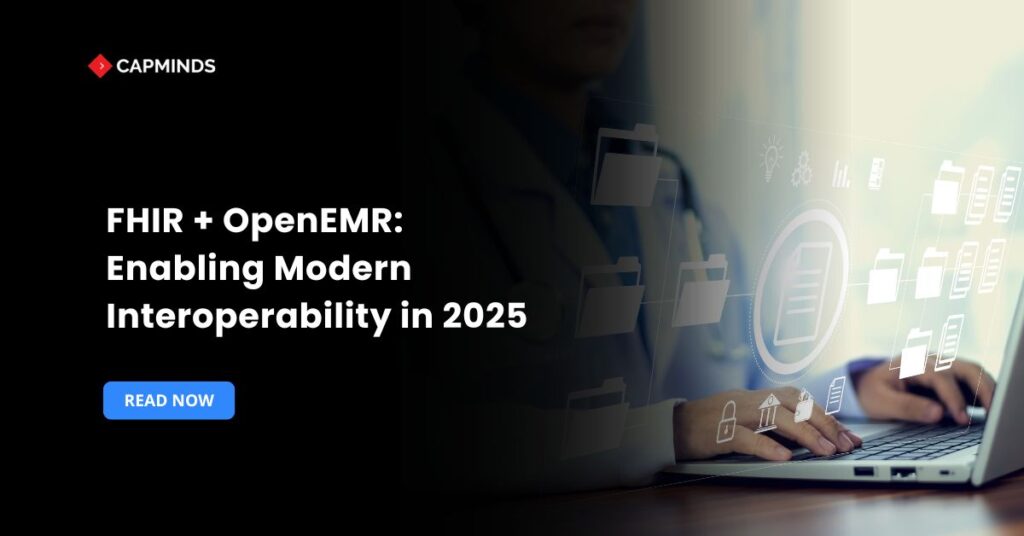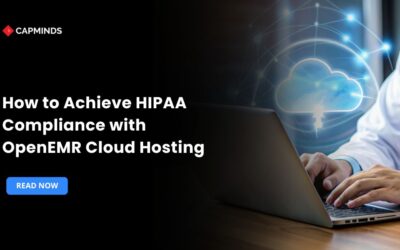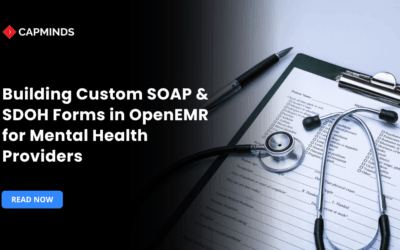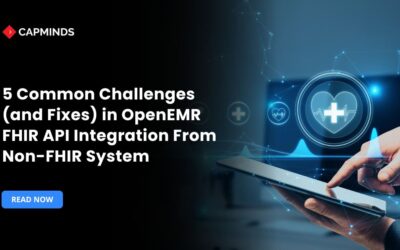FHIR + OpenEMR: Enabling Modern Interoperability in 2025
The healthcare sector shift toward data-driven decision-making and patient-centric models makes seamless clinical data exchange, which is not just an advantage but a necessity.
FHIR standard becomes the backbone of health data exchange, pairing it with a flexible, open-source EMR like OpenEMR helps in real-time integrations, app extensibility, and better patient engagement. In this blog, we’ll explore how FHIR and OpenEMR together are reshaping modern interoperability.
OpenEMR’s FHIR Implementation
OpenEMR, the leading open-source EHR, has steadily enhanced its FHIR support over recent releases.
- Core resource support includes full CRUD (Create, Read, Update, Delete) operations for core resources, including Patients, Practitioners, Encounters, Observations, Conditions, and Medication Requests.
- OpenEMR’s /fhir/{ResourceType} RESTful endpoint allows external systems and apps to connect with patient data directly.
- SMART launch environment support allows embedded third-party decision support or patient-facing tools directly within the EMR interface, streamlining workflows.
- Administrators can create facility-specific profiles, such as local lab codes, quality measurements, and register them with the FHIR server for enforcement during runtime.
- Integration with prominent terminology servers (SNOMED CT, LOINC, ICD-10) allows for semantic interoperability.
Clinical and Operational Needs for 2025
Seamless interoperability is essential for care continuity, compliance, and patient engagement. OpenEMR’s FHIR features offer an affordable, scalable path to meet these evolving clinical and operational demands.
APIs allow people to sustainably access personal health data, encouraging involvement and informed decisions. Automated messaging, lab result intake, billing procedures, and clinical analytics increase practice efficiency.
Due to legal pressure and the demand for better data transfer, it is predicted that by 2025, over 90% of healthcare systems will have integrated FHIR APIs.
FHIR Basics and How It Powers OpenEMR’s Capabilities
FHIR is built with resources, which are self-contained modules that reflect clinical ideas. Each Resource is described in JSON or XML, with a standardized format and metadata.
- FHIR uses HTTP methods (GET, POST, PUT, and DELETE), allowing developers to interact with Resources just like any other modern online service. This significantly simplifies integration while also leveraging current RESTful design experience.
- FHIR integrates with OAuth2 and SMART on FHIR to provide safe, token-based authorization. Resources allow implementers to identify which elements of the specification they support, making it easy to find partner capabilities.
Together, these standards ensure that OpenEMR not only stores and structures health data effectively but also communicates it in a format that’s future-proof and universally compatible.
1. Technical Foundations: FHIR R4, OpenEMR 7.x, and RESTful APIs
Faster Healthcare Interoperability Resources
FHIR combines RESTful APIs and JSON/XML communications to communicate different “resources” like as Patients, Observations, Encounters, making it easier to construct modular and scalable health IT solutions. Many companies, like OpenEMR, use FHIR Release 4 to ensure broad compatibility.
OpenEMR 7.x with FHIR Integration
- OpenEMR 7.0.3 supports PHP 8.1-8.4, MariaDB 10.5-11.x, Docker deployment, and ONC certification, vital credentials for compliant interoperability.
- Its FHIR API complies with the R4 specification and supports US Core Implementation Guides, such as CCD, Care Plan, and Bulk Data export.
- The Swagger UI is included, exposing all FHIR endpoints for testing, demo, and integration.
2. Integration Strategy: From APIs to Production Grade
Define Your Integration Goals
- Start by identifying the types of data your organization needs to exchange patient demographics, lab results, referral details, billing records, and more.
- Identify consumer, provider systems, HIEs, telehealth, patient apps, and analytics platforms.
Stakeholder Alignment
Involve clinical, IT, and compliance leaders early to:
- Clarify consent models
- Enforce data security
- Prioritize realistic workflows
Technology Stack
- Core EMR: OpenEMR 7.0.3+
- API Layer: FHIR REST endpoints for core resources
- Middleware/Transforms: HL7 v2 ingestion and transformation to FHIR for legacy systems
- SMART on FHIR Clients: Patient-facing apps that authorize via OAuth 2.0.
Security & Compliance
- Enforce TLS 1.2+ across all API endpoints.
- Implement granular access control per user or app.
- Enable detailed audit logs, traceability, and alerting for unusual activities.
Testing Environments
OpenEMR Foundation offers public FHIR sandbox endpoints ideal for integration, prototyping, and testing.
Related: FHIR, TEFCA & UDS+: How Enterprise-Scale Health Systems Are Gearing Up
3. Best Practices for Real-World Deployments
Leverage Docker and modern infrastructure to simplify deployment and upgrades, enabling version-controlled, reproducible environments.
Use the HL7 v2 + FHIR Hybrid Approach
Many laboratories and older systems still use HL7 v2 messages. Use transformation tools to convert them to FHIR observations or outcomes.
Bulk Data for Analytics
OpenEMR enables FHIR bulk data export, allowing you to efficiently feed data to analytics engines or centralized HIEs for population health reporting.
SMART for FHIR Extension
Create or integrate SMART applications for patient access, clinical decision support, or chronic care, even CIIPS Smart CDS modules include PlanDefinition $apply support.
Version Control and Change Management
- Manage FHIR profiles, token setups, and transformation scripts using Git.
- Audit logs are useful for troubleshooting message delivery, API failures, consent disputes, and so forth.
Performance and monitoring use instrument queries and bulk outputs to prevent hindrance and grow horizontally as needed.
4. Driving Clinical and Administrative Innovation
Clinical Decision Support
SMART for FHIR CDS Hooks are activated upon order submission, interrogating patient Conditions and Allergies to provide context-aware recommendations, decreasing mistakes, and simplifying guideline adherence.
Research Data Aggregation
De-identified FHIR data is fed into analytics systems, increasing cohort identification and clinical trial recruitment while maintaining privacy.
Mobile Patient Access
Patients utilize smartphone apps to examine their own FHIR-formatted records, book appointments, adjust prescriptions, and submit wearable data, which are all synchronized with OpenEMR in real time.
Telehealth and Remote Monitoring
Video-consultation platforms query FHIR Observation Resources such as blood pressure, glucose measurements collected from wearable devices, swiftly integrating data into the clinician’s file.
Quality Reporting Automation
Health systems extract standardized FHIR bundles for value-based programs (e.g., CMS MIPS), which reduces human chart review and increases reporting accuracy.
Related: Achieving Interoperability at Scale: HL7, FHIR, and API Integrations with OpenEMR
CapMinds HL7 FHIR Service for Healthcare Practice
CapMinds offers the best all-in-one health interoperability solution for healthcare practices. Our HL7 FHIR service will understand your clinical needs and requirements to cater to our solution.
We have years of experience in this field, faced many challenges, and tackled them with ease. Why can CapMinds be your Go-to Interoperability Solution?
- We are experienced professionals with years of experience in the field.
- Our technical team is an expert that will analyze your healthcare practice thoroughly to tailor the Interoperability solution.
- We prioritize safety, security, encryption, and authentication to protect your healthcare practice’s patient data.
- Our comprehensive solution ensures seamless interoperability, adhering to industry standards and using standard protocols.
- We offer comprehensive training sessions to healthcare staff.
- Our affordable health interoperability solution benefits healthcare practices at all levels.
If you are searching for the best interoperability service for your practice, CapMinds is your choice. We can assist you by navigating all potential challenges and ensuring seamless health data exchange.
Reach out to CapMinds Health Data Exchange Solutions for your Healthcare Practice.




